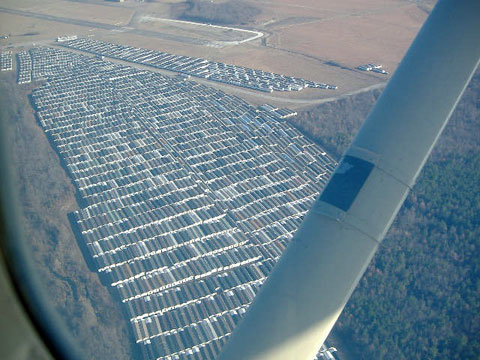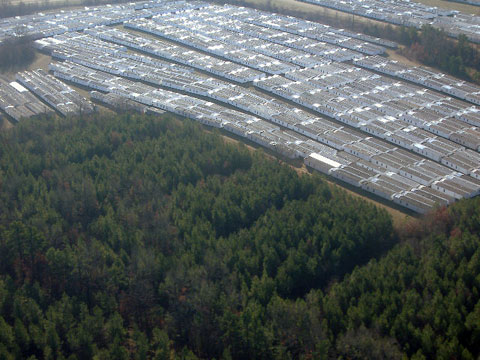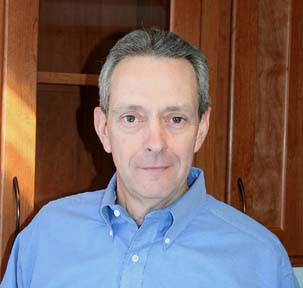News & Notes Archive - March 2008
Burlington Homes of Maine shuts down due to weak economy. Closure costs 70 full time jobs and surprises its dealers throughout the New England.
Oxford, ME — On February 20, Burlington Homes of Maine, one of the town’s largest employers, closed its plant for good, ending 14 years of operations producing both HUD-code and modular homes for a six state market that extended down to upstate Connecticut. Although the announcement surprised many of its dealers, the move was not entirely unexpected by plant employees. Last December the company suspended production and laid off its employees, including office staff.
Company management cited a weakening housing economy, lack of orders (current and predicted) as reasons for the closure.
Comment: I’m sad to see Burlington go. By all accounts the company built a solid home (it had to be, given Maine’s long, harsh winters), and its dealership network had overall a solid reputation for excellent consumer service. One can only hope that once the economy improves, the plant will reopen under a different name. In the meantime, don’t rule out considering the purchase of an existing lot model of the Burlington brand. Chances are the home will be listed at a very attractive price, and they’re built well regardless of the price point. If your dealer will go the distance to guarantee the home and its installation, you’ll be a good shape.
CDC tests confirm high levels of formaldehyde in many FEMA emergency travel trailers and manufactured homes (MH) provided victims of Hurricanes Katrina and Rita. What this means, and why buyers of manufactured homes need not worry.
In a much anticipated report released two weeks ago, the Center for Disease Control & Prevention (CDC) confirmed what people had been complaining about for years: the air inside a great many of the emergency travel trailers and manufactured homes provided to victims for temporary shelter by the Federal Emergency Management Agency (FEMA) in 2006 following Hurricanes Katrina and Rita, had unacceptably high levels of formaldehyde.
Of 519 trailers and manufactured homes randomly selected, the CDC reported the average formaldehyde level was 77 parts per billion (ppb) and ranged between 3 ppm and 590 ppm. Compare this to the commonly found levels of between 10 and 20 ppm. Long-term exposure to air with these high levels can cause nosebleed, itchy eyes and throats, pneumonia, and cancer.
When FEMA set up a formaldehyde call center last summer, it logged more than 7,000 complaints. FEMA has since promised to re-locate at its expense not only the families of the 519 abodes tested, but virtually everyone currently living in a FEMA trailer or manufactured home (38,000 families!).
Now, aside from this latest example of federal government ineptitude in the wake of the largest U.S. internal migration every caused by a natural disaster, folks who are contemplating the purchase of a manufactured home are right to ask, “Should I be worried about formaldehyde in my new manufactured home?
The answer, in my judgment, is, No, not at all, unless you happen to have a history of a very rare condition (one that has yet to be recognized by mainstream medicine) called multiple chemical sensitivity (MCS). For one physician’s take on MCS, goto http://www.quackwatch.com/01QuackeryRelatedTopics/mcs.html.
Here’s why: In contrast to travel trailers, which have no required standards for air quality, HUD mandates strict safety standards for indoor air emissions for manufactured homes. As a result, the manufactured homes randomly selected by the CDC for testing showed on average around six parts per billion, comfortably below the hazardous levels set by both HUD and the EPA.
To be sure, some homes did test for unsafe levels, but I believe this is because the homes tested were really cheaply constructed (i.e., used lots of particleboard components that contain formaldehyde) and never aired out.
In my view, the root cause of this dust-up (pun intended), is, FEMA's post-Katrina requirements for a minimally constructed MH abode resulted in the rushed construction of 24,000, singlewides with low quality construction features, including chemically-drenched, beach towel-thin carpeting, and tons of particleboard components. Price to FEMA: $34,500 per SW, a good deal for the mfrs.). These boxes were then sealed shut, shipped, and put in storage in high-humidity locales such as Hope, AR, where they cooked in the sun for more than two years with no ventilation to allow the formaldehyde to dissipate, a process called out gasing. A guaranteed toxic recipe. Below are a couple of images from the immense storage area at Hope, Arkansas. For details, please see the February 2007 News & Notes

The Hope storage site can easily be seen from space. Over 10,000 cheapo singlewide homes, built in a hurry, still waiting deployment.

Last month, in the wake of tornadoes that ripped through Tennessee destroying 517 homes and 61 manufactured homes, FEMA said the agency has 5,650 of these homes available for use, and that “300 were prepped and ready for immediate deployment.”
Bear in mind, too, that even new site-built homes are made with some components that contain formaldehyde–for example, curtains, drapes, carpets and particleboard products– and they, too, need to out gas and dissipate over time. But new site-built homes have months during their construction for outgassing to occur, whereas manufactured homes are built in a matter of a few days, then sealed and shipped from the factory.
This said, given the average three to five weeks needed to install a manufactured home on site before move-in, chances are a great deal of the out gassing will have taken place before you take occupancy. In any event, the bottom line is, homebuyers of new manufactured homes can rest assured that formaldehyde levels in their homes will be far below levels that would be regarded as unsafe. Note: if you still have concerns, don’t hesitate to call direct to the homebuilder’s factory and request assurances from the company’s engineering department. And tell them I recommended you do so.
Interview: 15 minutes with...Joe Stegmayer
Note: In my role as an industry observer and consumer advocate I speak with people at all levels of the manufactured home industry (MH) to gain insights I share with my readers to help them be better informed. Some I have interviewed for a one-page column that runs in an industry trade publication. In return the magazine runs an ad for the Grissim Guides. No money changes hands. I insist on this. Aside from book sales, I neither solicit nor accept a dime from the industry, and my readers have my assurance I intend to keep it that way. Here’s this month’s interview:

Joe Stegmayer, CEO of Cavco Industries, Inc. of Phoenix, AZ
Who: CEO, Cavco Industries, Inc., of Phoenix, Arizona, the state’s largest MH producer.
Background: Age, 56. Born in 1951 in Tenafly, NJ (“a small town in the northeastern part of the state, where I lived until I graduated from high school”). Moved in ’69 to KY to attend U. of Louisville, graduating in ’73 with a B.A. in marketing and finance. Accepted a position in OH, working for Worthington Industries, a publicly held steel manufacturing company with $40 million in annual sales, headed by founder John McConnell. “I worked directly under McConnell for 20 years. It was a great ride. A very innovative company that treated its employees, customers, vendors and shareholders properly, following the golden rule. John was my mentor; I learned a lot.” There, Stegmayer held positions as VP for corporate development, head of mergers & acquisitions, Executive VP and CFO, and chairman of joint ventures with companies in Germany and Japan, the latter involving auto parts for US Honda. In two decades Worthington grew to become a member of the Fortune 500 and was recognized in several best-selling books.
In ’84, when Clayton Homes went public, he bought stock as a private investor, “my first introduction to manufactured homes.” A year later, he met Jim Clayton at an investor conference. “We got to know each other and later that year Jim invited me to serve on his board of directors.” In ’93, after seven years as an independent board member, he agreed to serve as Clayton’s president (Clayton would remain board chairman). A year later, while living in Knoxville, TN, he married wife Delene.
“Clayton’s goal was to take the company to the billion-dollar size level, with a hundred million in net earnings, which we achieved by 1997. Jim and I worked closely together. He is very intelligent with vast knowledge of the industry and was a consummate teacher, I learned a tremendous amount.”
In 1998 Champion Enterprises lured Stegmayer away to its Michigan HQ to help grow that company, serving as Executive VP, CFO and chief strategic officer, a role that lasted a little over two years.
In 2000 he accepted an offer from Dallas-based Centex Corp, a major home production builder, to head its manufactured housing group. The group included land development, a finance arm and Cavco Industries. “Centex wanted to acquire other MH companies and expand the subdivision development and mortgage business units.” But by 2003, with the MH industry falling and in disarray and finding no suitable candidates for acquisition, Centex opted to spin off Cavco. He agreed to remain as Cavco CEO following the transition. The Stegmayers have two children, a daughter Eliana, 11 and son Luke, nine.
- Q: Cavco’s third quarter results reported in late January show continued profitability despite a very difficult industry-wide environment. Any particular reasons?
- A: Keeping our overhead low has been important, but Cavco’s product diversity and quality have been the key factors. Our park model and cabin business has been a bright spot. We’ve also benefited from the high degree of customization we offer. We’re something of an industry hybrid on that score, offering more customization than most builders. For example, we’re happy to create a floor plan from a customer’s drawing. We also design custom lines for developers of both communities and subdivisions, two areas we’ve focused on for years.
- Q: Have park model sales been more resistant to market softness?
- A: Definitely. It’s a lower priced product that’s used mostly for second homes and seasonal residences. They’re less expensive than a condo and have better value than a time-share–typically they retail in the low thirties-to-fifty thousand dollar range. Most go into park model communities exclusively developed for them, or into special sections in traditional parks.
- Q: You’ve recently introduced a new line of larger cabins as well as single section homes that are sized between park models and typical HUD homes. How are they faring?
- A: Quite well. We build them to the HUD code or as modulars in either single or multi-module styles. They are suitable for private land placement, for people who want more space than our camping cabins but with the porches and other rustic features. That’s a growing market for us. We’ve also introduced 600-700 sq. ft. homes for community residents who don’t want a large multi-section, but do want a residential look with amenities such as full tape and texture and 10’ flat ceilings.
- Q: How to you view community renewal (replacing old homes in MH parks) in the Southwest region?
- A: It’s soft now due to the housing slump but its long term prospects are excellent. We think we’re in great markets: Arizona is the fastest growing state in the US, California has the largest population, and Nevada and New Mexico are growing The over-55 age group is the fastest growing demographic, and people want to move to this area for many reasons.
- Q: Your thoughts on issues facing the industry?
- A: That’s a big subject. I’ve been more bearish in recent years than some, but I’m a long-term optimist. We can produce much needed quality, affordable housing at a better square-foot price than anyone else. There’s also a lifestyle change issue that’s not about affordability–people are looking to downsize from the McMansions we’ve seen these last 20 years. Beyond this, there’s going to be a tremendous replacement market emerging as more of the two million homes built decades ago, just prior to the HUD code, reach the end of their practical life, just as site-built homes do.
- Q: You’ve garnered quite a reputation for personally phoning home buyers who report problems getting warranty service. Are you still making calls?
- A: Sure, in fact I’m about to visit one in Tucson with a plant GM. It’s just part of a culture here we’ve developed over time. Our people are accessible and they understand it’s really all about the customer. Service costs may run a bit higher than some of our peers in the industry, but we don’t mind, because it is not the result of a misstep in quality, it’s simply about going all out to achieve customer satisfaction. Some of the customers I speak with are very surprised –“Wow, I asked for the president, but I didn’t think I’d get the president.” (laughs). But doing these things really helps tell a story about Cavco. It’s a story customers are likely to tell others.